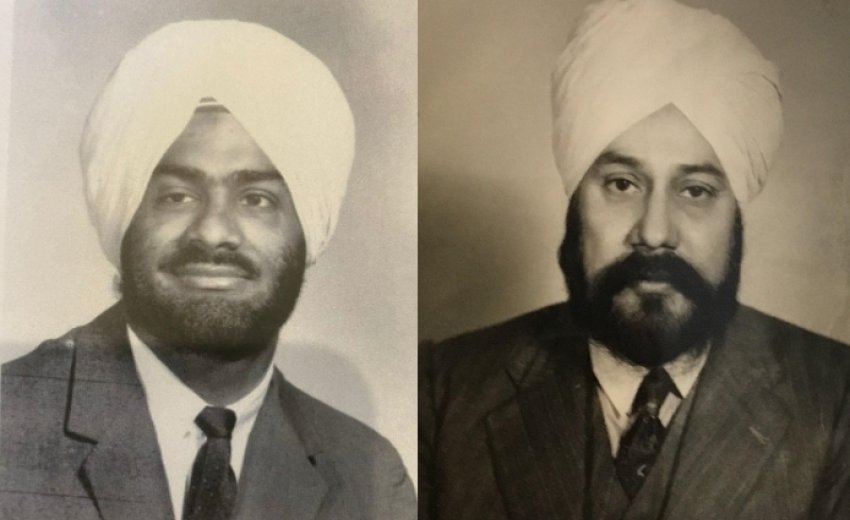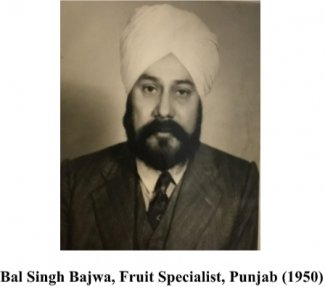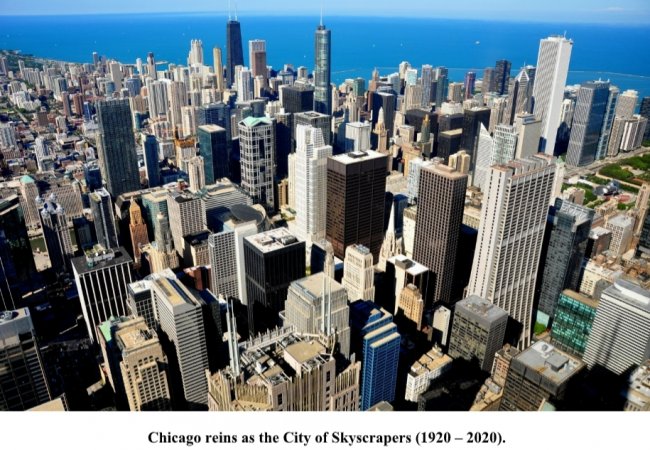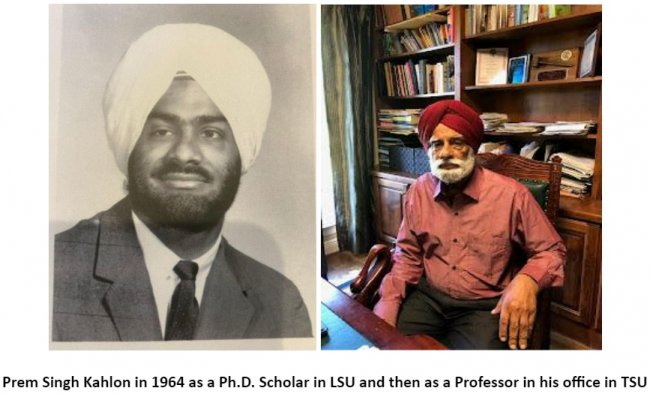I was born and grew up in a small village Majhiwala Bhuler (Chak # 270, Rakh Branch), tehsil Tobha Tek Singh, district Lyallpur (now Faisalabad in Pakistan). After the Partition of India in 1947, my family moved to village Chhokran, tehsil Malerkotla, district Sangrur. I started my school education in Govt. Primary school Lassoi, situated 4 km. away from my village in Feb., 1948. It was a one teacher Primary school with one unfurnished room. Most of the classes were held outside under the shady trees in summer and in bright sunshine in winter. The students had to carry their own mats for sitting on the floor. Every class had a Monitor who was a sort of bully to maintain discipline in the class in the absence of a teacher. I learnt Punjabi and basic rules of Arithmetic in grades one and two. When I joined Lower Middle School in Bhurthala Mander having three teachers in 1950, Hindi was introduced as an elective subject in grade three and English language in grade five. Science was not introduced as an elective subject till 7th grade but we were taught Social Studies (History, Geography and Civics).
I joined Khalsa High School Lassoi in 7th grade. Our English teacher Inderjit Singh was a hard task master. I learnt the rules of grammar and started making sentences. Science was introduced at elementary level. Our Science teacher had the reputation of failing in his B.Sc. examination six times and ultimately he passed under a special chance granted by the Punjab University as a rare gesture. I passed my Middle School examination with high scores in English and Mathematics. I was advised by Master Harbhajan Singh Virk, a distant cousin, to join Govt. High School Malerkotla to study Science and Drawing combination for joining Polytechnic or an Engineering college after matriculation. I followed his advice and cycled twenty kilometers daily on a kutcha road to study in Malerkotla. I stood first in both 9th and 10th classes of my school. When I scored 89% in English language in 9th class, the Headmaster of my school was not impressed and he held an enquiry and my answer sheets were re-examined by the English language teacher. However, I stood my ground.
My financial situation worsened just after my admission to Govt. High School, Malerkotla. I lost my support after a murder in the family. The story of my trials and tribulations has been described in my autobiography “My Journey in Science: An Autobiography of an Indian Scientist” [1]. I was living a life of penury and there was no hope that I could continue my studies in college. I went to my Headmaster, who held the inquiry, to support me in my efforts to join the Science stream in Govt. College, Malerkotla. He personally led me to the office of Principal of the college and pleaded with him to provide me financial support. I was admitted to the Non-Medical Group in Science with full fee concession and grant of books from the Library for the full duration of my studies. The other teacher who provided all logistic support was my Science teacher, Harjit Singh Rai, who expired in 2021 in Calgary at the age of 93. I dedicate my essay to the memory of my benefactors, Headmaster Raghunath Sahai and Harjit Singh Rai.
To cut the story short, my journey in Science continued via Govt. Mohindra College, Patiala (B.Sc., 1961), Aligarh Muslim University, Aligarh (M.Sc., 1963), and Marie & Pierre Curie University, Paris (Doctorate in Nuclear Physics, 1972). The tale of my struggle to reach the pinnacle of glory is fully illustrated in Reference [1]. The purpose of this essay is to highlight the role of two brilliant sons of the soil, who served as my ROLE MODELS in School and College days.
Bal Singh Bajwa: I have vague memories of my visit to Layalpur (now Faisalabad) in 1946 as a young child of five years when my mother took me along to stay for a few days in the Kothi of Bal Singh Bajwa, who was a Class I officer of Punjab Govt. under the British empire. His daughter, Sukhraj Bajwa, was of my age. We used to play in the lawns of Bajwa house. One day, Bajwa Sahib entered the house and spotted me playing with his beautiful daughter and pulled me up. I am not sure what was the reason? Perhaps, we had spoiled the well manicured lawns of his Kothi. But his wife, Attar Kaur, a kind lady who always supported my mother in her days of adversity, intervened and our mood to play the next day was restored.
During my School days in village Chhokran, Bal Singh Bajwa frequently used to visit his brothers living in Chhokran, who were cultivating his agricultural land. During late evenings under the moonlit night, he used to tell some tales of his rendezvous in America. Once he told about his visit to Chicago with high rise buildings touching the sky. Chicago was the birthplace of Skyscrapers during 1920-30 when Bajwa was a student at UC Berkeley. The Empire State building in New York was a later construction in 1930 when Bajwa returned to India. He used to recall his forays in watching national games of America and himself playing American football. In Chhokran, no one called him by his name but he was called “Vilayat Pass (educated in England) Uncle” out of respect for his higher education in the USA and England.
Once, during a dust storm, he landed in the village and, not finding his host, he came to spend the night in our house. My mother and Nani (maternal grandmother) took special care to entertain him by cooking delicious food. It was a hot summer day. I was put on duty to fan him while he was having his dinner. He praised my act of serving him. I started thinking that one day I shall try my luck by going abroad for higher education like Bajwa to be called “Vilayat Pass”. It was a great motivation for me as a rustic rural lad of ten years.
The Biography of Iconic Bal Singh Bajwa: Bal Singh Bajwa, son of late Sardar Sant Singh Bajwa, was born in 1901 in the same village, Majhiwala Bhuler, where I was born forty years later in 1941. He was the son of a farmer, the eldest of seven siblings, six brothers and a sister. He passed his Matriculation examination from Zamindara High School in village Jalandhar Araiyan situated at a distance of 6 km from Majhiwala Bhuler. This school was founded by Khan Sahib Mehar Abadan, who sold his land to pay for the construction of its building. It was the first high school established in the rural areas of the then united Punjab in 1911. After Partition, it was renamed as Govt. Islamia Zamindara High School and upgraded to a Secondary School. Bal Singh Bajwa scored first division, topped in his School and won a Scholarship for higher studies.
The British occupation of Punjab proved to be a blessing in disguise. To bring all round development of Punjab, the British started new educational institutions and canal colonies for economic development based on agriculture. Nine canal colonies were created during 1892 – 1905 in the arid areas of west Punjab after digging up canals by creating barrages and head-works on the rivers of Punjab. Bajwa’s village was irrigated by the outlet number 270 of the Rakh Branch, hence it was named Chak #270. The Rakh Branch originates from Lower Chenab which comes out from Khanki Head at the river Chenab. Layalpur was established in 1892 as the first planned city of Punjab. To cater to the needs of settlers in the canal colonies, the British opened a Govt. College in Layalpur in 1897 and an Agriculture College in 1906. This was called Punjab College of Agriculture and Research Institute and its foundation stone was laid by Sir Louis Dane, Governor of Punjab. In 1961, it was upgraded to the University of Agriculture, Faisalabad.
Bal Singh was a meritorious student and had won a scholarship in Matric. He joined B.Sc. agriculture in Punjab College of Agriculture, Layalpur, which was a residential college, and passed out in 1921. He was declared a topper in his batch and he won a gold medal. After serving for some years in the Agriculture Department of Punjab, he won a scholarship for higher studies abroad. In 1926, he sailed for the United States and joined the University of California, Berkeley campus for his Master degree. He maintained his top position even at Berkeley.
Before going to UC Berkeley, Bal Singh had planned to visit England on the way back. To utilize his visit to England, he got admission to some institute in London. He stayed at Royal Botanic Gardens at KEW near London for studies in botany for eight months. Thus he was fully armed with his specialized training as a ‘Fruit Specialist’ before his return to India in 1928.
On return, he joined his parent department of agriculture and in 1941 became fruit specialist (Punjab agriculture Class -1 officer). On Partition of India, the Bajwa family migrated to Jallandhar city in 1947. While in the service of Indian Punjab Govt., he prepared a proposal for fruit development in the province. He selected fertile areas and established ‘Garden Colonies’ in each district of Punjab successfully. He worked in the same capacity of Fruit Specialist till he retired in 1956.
Bal Singh Bajwa also published some important research Papers for development of Orchards and Fruit Industry in Punjab [2-3]. He was an active Member of the Horticultural Society of India established in 1942. He was made Treasurer in 1949 when the Society was reorganized after the Partition of India. He was entrusted with the office of Vice-President in 1950 when Prof. W.B. Hayes was elected as President of the Society. The society was running the Indian Journal of Horticulture in which Bajwa published his papers.
He visited Afghanistan, Iraq and Nepal as an advisor for fruit development in 1945-1946. He went on deputation to Palestine to study the working of Jewish commune settlements and their model of development of agriculture under semi-arid conditions. He was advisor to Indian princely states of Jaipur, Jodhpur, Faridkot and Nabha during and after his service in agriculture department.
After retirement, he was engaged in social and cultural activities. Bal Singh Bajwa was General Secretary of Governing Council of Layalpur Khalsa Colleges for Boys and Girls in Jallandhar. When I passed my M.Sc. (Physics) In 1963, I was looking for a job in some college. He advised me to apply in Layalpur Khalsa College, Jallandhar where I was selected as a Lecturer to teach Physics. After two months, I got selected in Guru Nanak Engineering College Ludhiana at almost double the salary. I resigned from my job and applied for no objection certificate. My application went to Bajwa for approval. He did not spare me and asked to pay three months salary in lieu of notice which I had failed to give before resigning my post. I never met him after this. He was a stickler for discipline and did not spare me from meeting my obligations to the college by leaving in the middle of academic session.
He was Founder President of Gurdwara Singh Sabha, Model Town, Jallandhar which was designed by his son, Baldev Singh Bajwa, a civil engineer by profession. His eldest son, Shamsher Singh Bajwa, was a Mechanical engineering graduate from AMU, Aligarh in 1951. I followed him to join AMU in 1961 for my M.Sc. in Physics. His youngest son, Daljit Singh Bajwa, has been living in Kitchener, Ontario, Canada since 1974. He qualified in B.Sc. agriculture in 1950 and is a holder of LL.B. degree in Laws. His daughter, Sukhraj Bajwa, was doing her B.A. when I started teaching in Layalpur Khalsa College, Jallandhar. He helped his younger brothers in their pursuit of education as advised by his father, Sant Singh. Bal Singh Bajwa died in 1972 of cardiac arrest. He left a rich legacy in the shape of Garden Colonies in Punjab.
Prem Singh Kahlon: He was born on June 16, 1936 at village Sihowal (Chak # 417, Jhang Branch) in tehsil Toba Tek Singh and district Lyallpur (now Faisalabad, Pakistan). His father, Bahadur Singh, was an eminent person in the rural community of the area. His mother Harnam Kaur Bajwa died when Prem was a toddler. His uncle, Nazar Singh Kahlon, was in his teens. He took interest in the upbringing of Prem from his early childhood. He is so attached to his uncle that he keeps his framed photo in his office. The other lady who took care of Prem was his grandmother. She died in my village Chhokran after living for almost a century.
My first encounter with Prem Singh took place in 1953 when I was studying in Khalsa High School, Lassoi. After passing his Matriculation from the same school in 1952, he joined B.Sc. in Govt. College of Agriculture, Ludhiana. During summer vacation, he used to spend his time helping his brother, Ranjit Singh, in farming activities. In School days, grazing cattle was my pastime, like many other boys of farmers. Our hero was Shisho (Bakshish Singh), a strongly-built boy who was our ring leader. We used to listen to his sermons of rugged common sense. Once, he pronounced that to get prominence in life, one must either become a Saint or a Dacoit. The reason was obvious: Punjab had some famous Saints like Sant Attar Singh of Mastuana and Sant Isher Singh Rarewala; and on the other hand, Janga Dacoit was ruling the roost in the entire PEPSU area during 1953-55. He never advised us to study and become famous in life.
He went to primary school in his village where his teacher Shukar Din was only a Middle School (8th grade) graduate. During those days, the British Govt. used to award scholarships in a competitive exam in 4th grade for 6 years up to high school based on your faith and population. For example, in Lyallpur district, they will select two Muslims, one Hindu and one Sikh under this scheme. Prem Singh secured the top position in Toba Tek Singh but at district level, he failed to win the Scholarship. He had lost confidence because he could not complete his reciting of Japuji that morning. His grandmother had advised him to recite Japuji as a daily routine to seek blessings of Guru Nanak for success in his life. He remained loyal to her advice all through his life.
After finishing the fifth grade in Pakistan, Prem Singh was in the 6th grade when the family migrated to Indian Punjab in 1947 and settled in Patiala State. In January 1948, he was admitted to 6th grade in Govt. High School, Amargarh. The medium of instruction was Punjabi in Gurmukhi Script, rather than Urdu, in Patiala State. Fortunately, refugees were allowed to write in Urdu script instead of Gurmukhi and Prem Singh cleared his Middle School examination with 3rd position in his class. In 1950, he joined Khalsa H/S Lassoi and finished his Matriculation (10th grade) in 1952, securing the first division and second position in his class.
During his stint in Govt. Agriculture College, Ludhiana, Prem Singh was too much involved in extracurricular activities. He was playing almost all games as a member of his College team and also participating in athletics. He was captain of college Basketball team, captain of winner Kabaddi team and won first position in weightlifting in college. As a consequence of his too much involvement in Social, Cultural and Sports activities of his college, he failed to secure first division in B.Sc.
He had to make a big sacrifice to recover his lost position in academics. His family was not rich and depended upon farming activities on a few acres of land. He had to borrow money from his uncle who treated him like his own son. The other way was to mortgage his own piece of land to raise funds for his education in the USA. I guess he did not choose the second option? He did very well in studies in LSU at Baton Rouge and after his Masters degree in Science (M.Sc.), he was awarded a very prestigious Rockefeller Foundation Fellowship for his Ph.D. studies and finished his Graduation in 1964 bringing laurels to his family.
After finishing his Ph.D. in 1964, he started teaching in Taladega College in Alabama. One day in 1965, he went to drink in a bar along with a Professor of Mathematics. Next day, he observed that a young girl was laughing in her sleeves in his class. On asking, she replied: “Mr. Singh, I saw you in the bar”. He felt so embarrassed and started thinking that it was his turban which was the cause of all the trouble. He asked himself: “Should I remove the turban or stop going to the bar”. He recalls: “In 1965, I cut my hair but kept using a turban off and on but removed the turban when I went to drink”. One day, I was in the swimming pool at the campus without a turban and the same girl asked me “Mr. Singh, where is your "Bun" (Jurra)”? One day later, Prem saw her note book where she had drawn his pencil sketch (picture) with “Jurra” in the middle of his turban on his head. Prem was remorseful and on returning to his room, he felt so ashamed and started crying. He started wearing a turban after this episode. Prem Singh is very actively involved in Interfaith groups and delivers talks about Sikhism. He is founder Member and Chairperson of Nashville Gurdwara Board registered under South-Eastern Sikh Religious Society of USA.
I am not fully convinced by his arguments. He could have gone to a bar to drink without cutting his hair and removing his turban. There was no need to hide his identity as a Sikh. I know many others telling me such stories but I consider it as an alibi. I had to face much more harassment in University of Paris (1970-72) due to my turban initially but once the French students realized that I am not going to remove it, they became very friendly with me and my Sikh identity was an added advantage in my official dealings with University authorities. The office secretaries and ladies in University restaurants were going an extra mile to serve me on priority basis.
Prem Singh Kahlon was Director of the MARC Program for 30 years at Tennessee State University (TSU). He was inducted into Gamma Sigma Delta Honor Society indicating that he was among the top 10 percent of his graduating class in LSU. He recalls: “With Guru's blessing, my nickname was "Smart Indian" in the university”. He had many honors to his credit like honoring him by the city council of Baton Rouge. In those days, black people including South Indian students could not even go to a restaurant and eat. However, when he went he felt privileged as he was called a Prince and some customers felt proud to entertain him with food and drinks. He feels very grateful to Guru Nanak who protected his honor and dignity in all circumstances.
Prem Singh retired as Professor of TSU in 1912. He published more than a dozen research papers and guided 15 M.Sc. and 10 Ph.D. theses. The details of his resume and achievements of life in India and in the United States of America are available in the websites listed under references [4-6].
Acknowledgements: I am grateful to Daljit Bajwa (91) and his wife Guddy Bajwa for providing salient features of the biography of his illustrious father, Bal Singh Bajwa, who was my Role Model in school days. I owe my thanks to Prem Singh Kahlon and his wife Darshan Bhatti Kahlon for the supply of material for collating the biography of Prem Kahlon, my Role Model in College days.
Hardev Singh Virk,
Professor of Eminence (Honorary) at SGGS World University, Fatehgarh Sahib
E-mail: [email protected]
References









